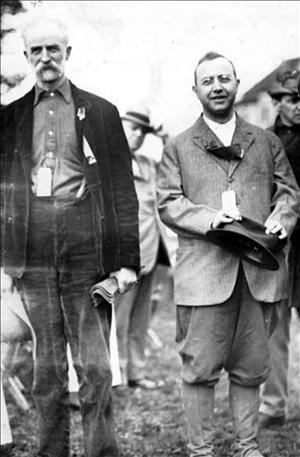On opening day of the fall term, October 4, 1926, the University of Washington Board of Regents demands the resignation of University President Henry J. Suzzallo (1875-1933). When Suzzallo refuses, he is dismissed. David Thomson (1870-1953), Dean of Faculties, becomes acting president. Suzzallo's firing follows two years of battling with Governor Roland Hill Hartley (1864-1952) over school expenditures, lumber and labor policies, and political rivalry. Supporters of the ousted president gather at his home in the evening to decide a course of action. University students demonstrate on campus and promise to strike if Suzzallo is not reinstated. Suzzallo asks the students to return to their studies, fearing retribution toward the school. Citizens begin collecting signatures to recall Governor Hartley.
The University of a Thousand Years
Henry J. Suzzallo became University of Washington (UW) president in 1915. A California native, he had earned prominence as Professor of Education at Columbia University. Suzzallo was young, persuasive, and a dynamic public speaker. The UW's regents believed he would bring stature to the university as well as the creativity needed to deal with issues facing an institution in transition.
Suzzallo faced several immediate challenges including departmental bickering, an inadequate physical campus, and problems resulting from the United States entry into World War I. Quickly proving his leadership ability, he brought resolution to campus factionalism and was able to maintain a qualified teaching staff despite the personnel drain imposed by the war. He spoke widely throughout the state and was a popular president who served on many citizen boards and committees. His goal was to build a solid support base for the university and its programs. Suzzallo considered himself a frugal president, but, as he contended, state colleges and universities not only spend the wealth of a community, they also create it.
Urban population growth had tripled most Pacific Northwest communities in the early 1900s, and enrollment at the University of Washington doubled during that time. Yet few significant changes had been made to the physical campus. Students lived in temporary quarters and attended crowded classrooms. As a result, the University of Washington was ranked near the bottom of 46 universities.
In one decade, Suzzallo added eight permanent campus buildings. Designed in Gothic style by the firm of Bebb and Gould, the new structures brought a cohesive look to the campus for the first time. Suzzallo sought to build a lasting legacy in both buildings and programs. He hoped to create, as he called it, "The University of a Thousand Years."
Governor Hartley vs. President Suzzallo
Suzzallo was accustomed to battling the legislature for funding, but the struggle turned bitter when Roland Hill Hartley became governor in 1924. Running on a platform to curb government spending, Hartley immediately challenged Washington state's institutions of higher learning. Being a lumberman, Hartley was also personally at odds with Suzzallo who, as member of the National Labor Board during wartime, had helped establish an eight-hour work day in the logging and lumber industry. In addition, Suzzallo's charismatic stature in the region was probably a political challenge to Governor Hartley. The governor and the president had similar working styles, both preferring to lead by making command personal decisions.
Suzzallo was successful in drawing endowments to the university, and most of the funds used for building construction did not come from taxes but from student fees and gifts. To Suzzallo, the university's struggle with the governor was not only financial. There were larger issues of independence at stake for the state's colleges and universities, and Suzzallo firmly opposed the governor's intervention and control. A state Department of Efficiency had been established in 1920, bringing close scrutiny to public institutions, and Hartley hoped to create a state-supervised board of laymen to control state educational institutions.
Issues came to a crisis in the 1925 legislature when the University of Washington successfully passed its appropriation bills without change. Governor Hartley vetoed the measures. When two members of the University of Washington Board of Regents retired in March 1926, Hartley named his own supporters to fill the positions. He then dismissed two other board members and replaced them in March and replaced another in May. The new Hartley-dominated Board of Regents officially dismissed Suzzallo on October 4, 1926. The remaining two original board members resigned in protest.
Suzzallo supporters rallied behind the president and began a petition to recall Governor Hartley. But Suzzallo's prominence was centered in the urban areas of western Washington, and the recall issue failed. Supporters were unable to collect enough signatures to place the initiative on the ballot.
Twenty-four days after Suzzallo's dismissal, the UW Board of Regents called for architect Carl F. Gould's resignation. For more than a decade, Gould had worked closely with Suzzallo, as a professor, a department head, an architect, and a personal friend. He had been chief architect for the university's new buildings. Now the board charged Gould with a conflict of interest, stating that "no one connected with our public schools can have any financial dealings with the school district where a profit might occur" (Booth and Wilson). Gould immediately resigned.
Following his dismissal, Suzzallo worked with the Carnegie Foundation for the Advancement of Teaching and served as its president in 1930. He died in Seattle on September 25, 1933.

